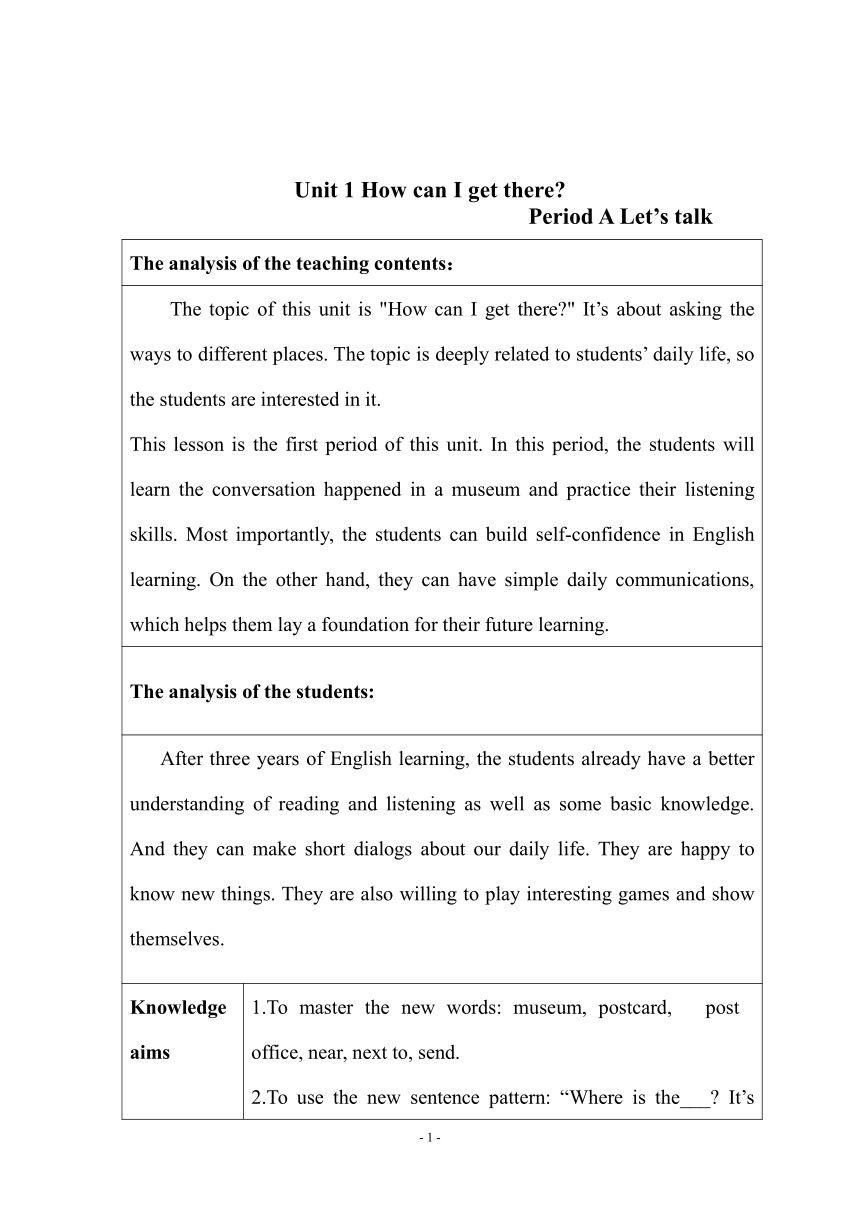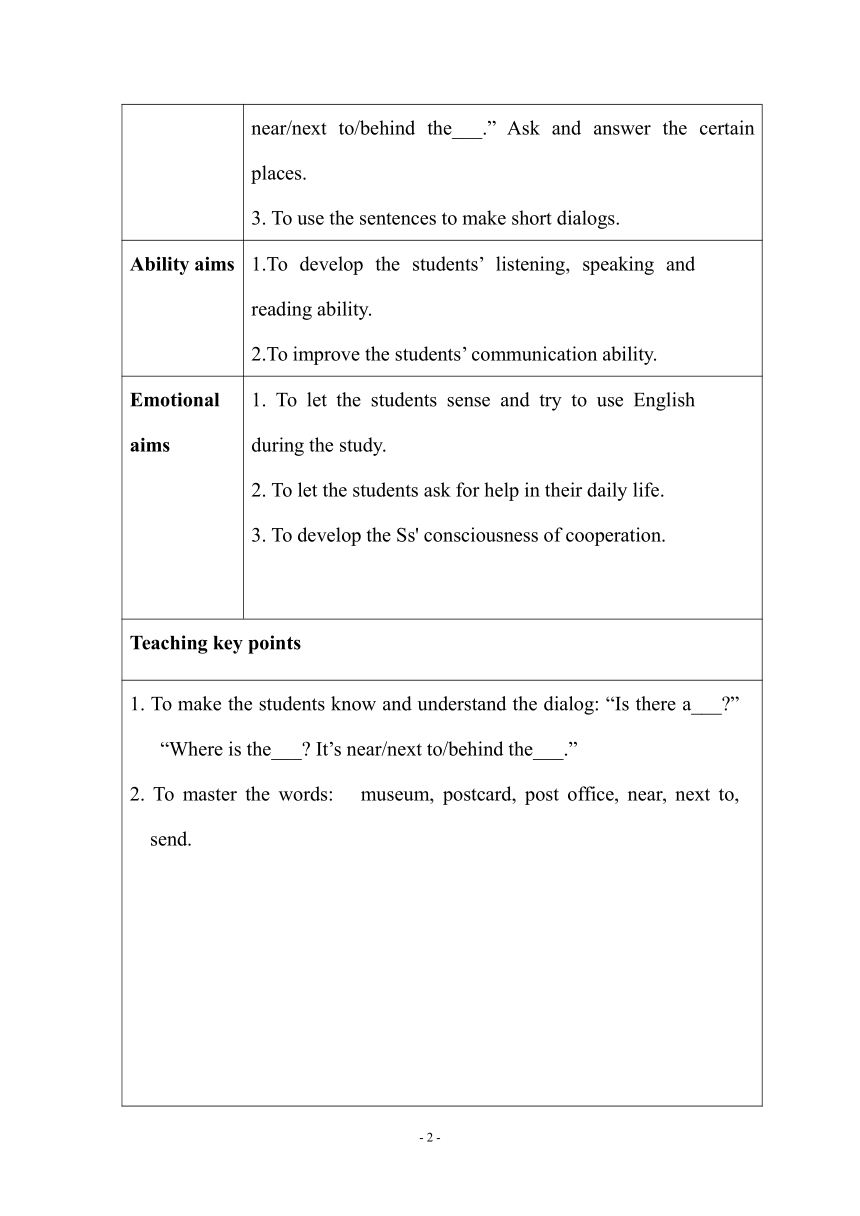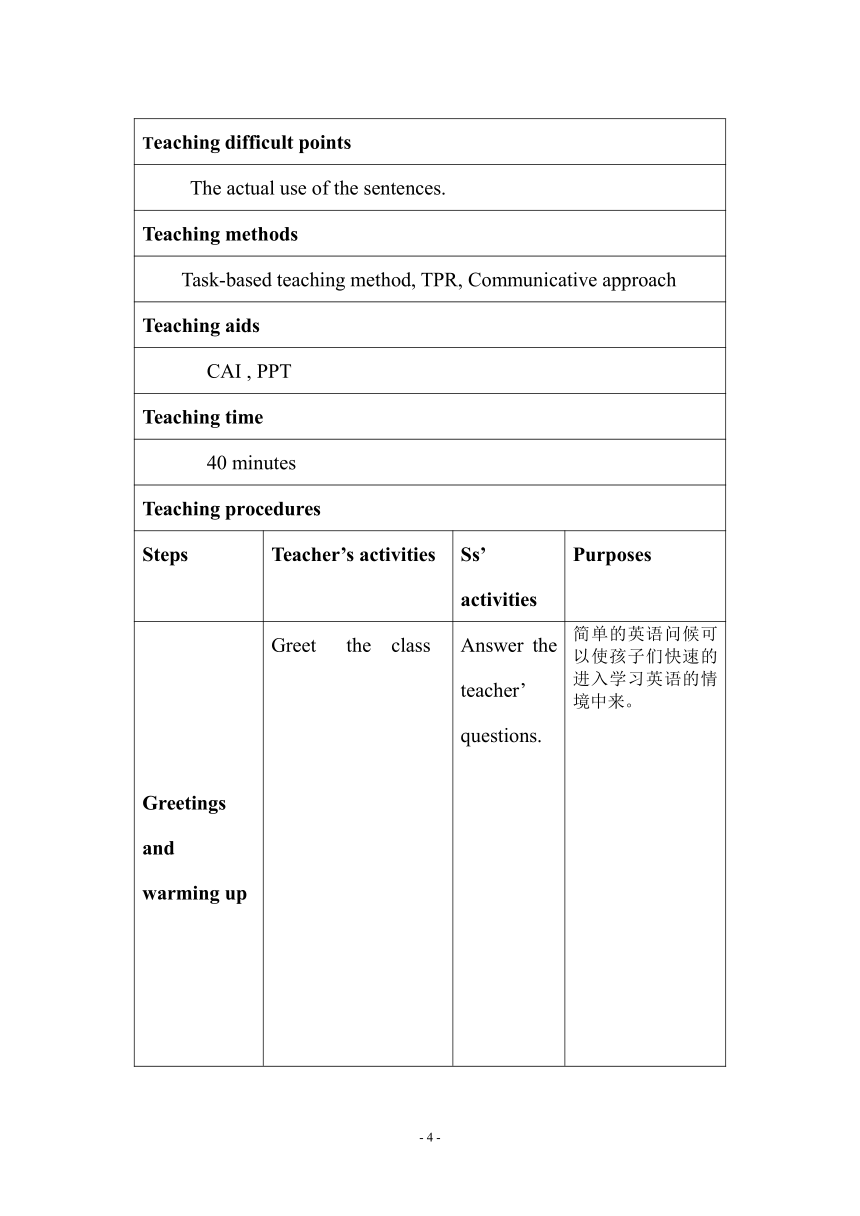Unit 1 How can I get there? PA Let’s talk 表格式教案
文档属性
| 名称 | Unit 1 How can I get there? PA Let’s talk 表格式教案 |  | |
| 格式 | zip | ||
| 文件大小 | 18.0KB | ||
| 资源类型 | 教案 | ||
| 版本资源 | 人教版(PEP) | ||
| 科目 | 英语 | ||
| 更新时间 | 2019-08-20 07:32:11 | ||
图片预览




文档简介
Unit 1 How can I get there?
Period A Let’s talk
The analysis of the teaching contents:
The topic of this unit is "How can I get there?" It’s about asking the ways to different places. The topic is deeply related to students’ daily life, so the students are interested in it.
This lesson is the first period of this unit. In this period, the students will learn the conversation happened in a museum and practice their listening skills. Most importantly, the students can build self-confidence in English learning. On the other hand, they can have simple daily communications, which helps them lay a foundation for their future learning.
The analysis of the students:
After three years of English learning, the students already have a better understanding of reading and listening as well as some basic knowledge. And they can make short dialogs about our daily life. They are happy to know new things. They are also willing to play interesting games and show themselves.
Knowledge aims
1.To master the new words: museum, postcard, post office, near, next to, send.
2.To use the new sentence pattern: “Where is the___? It’s near/next to/behind the___.” Ask and answer the certain places.
3. To use the sentences to make short dialogs.
Ability aims
To develop the students’ listening, speaking and reading ability.
To improve the students’ communication ability.
Emotional aims
1. To let the students sense and try to use English during the study.
2. To let the students ask for help in their daily life.
3. To develop the Ss' consciousness of cooperation.
Teaching key points
1. To make the students know and understand the dialog: “Is there a___?” “Where is the___? It’s near/next to/behind the___.”
2. To master the words: museum, postcard, post office, near, next to, send.
Teaching difficult points
The actual use of the sentences.
Teaching methods
Task-based teaching method, TPR, Communicative approach
Teaching aids
CAI , PPT
Teaching time
40 minutes
Teaching procedures
Steps
Teacher’s activities
Ss’ activities
Purposes
Greetings and warming up
Greet the class
Answer the teacher’ questions.
简单的英语问候可以使孩子们快速的进入学习英语的情境中来。
Presentation
Ⅰ places and dialog
T acts as a new visitor here, shows a map of the neighborhood.
T describes the places she wants to go, and show the words: park, library, zoo, post office, school, museum on the map.
3. T shows the sentences “Is there a___?” “Where is the___? It’s near/next to/behind the___.”
4. T asks for suggestions about other places to introduce “museum”.
5. T introduces Robin first then they go to visit the science museum.
Students listen to the T and try to answer the places: school, park, library ,zoo, post office, museum
Ss try to answer T’s questions using the sentence patterns.
Ss pay attention to T’s description.
以教师作为一个来访者的身份想要去一些地方为主线,并借助地图展示地点来复习park, library等单词。再通过谈话交流法引出单词“museum”,同时顺势引出该部分的三个练习句型。
教师通过介绍机器人Robin来为即将学习的对话做铺垫。
Ⅱ words explanation
1. T writes the words: museum, postcard, post office and send on the board and has a simple explanation.
2. T shows the picture of the museum.
Ss prepare to listen to the conversation in “Let’s talk”
Ss look at this picture and get ready for the following text.
通过讲解对话中即将听到的单词是帮助学生更好的理解即将听到的对话。
通过展示museum 内部的图片帮助学生在听对话的同时对对话发生的环境有一个空间的认识。
Practice
1. T asks students to listen to the tape of the dialog.
2.T gives them 4 questions about the conversation in “Let’s talk”
3. T plays the tape.
Ss listen to the tape and try to answer the given questions.
听读训练一直是英语课堂训练的重点,让他们脱离文本听则是锻炼学生的听力水平及对信息的捕获能力。
Production
The reading practice.
Role-act the dialog.
Ss read the conversation together then in groups.
Role-act the conversation in groups
各种形式的读,则是熟悉对话,教师及时给与纠正,为接下来的角色表演做准备。
小组合作表演培养学生的团队合作意识及表现能力。同时发展综合语言运用水平。
Summary
The teacher invites some students to make a brief summary of the contents we learnt in this class.
Make a brief summary of the new words and dialogues in this class.
将总结的主动权交给学生,让学生回归课堂中心,一方面检测了学生对课堂知识的掌握程度,另一方面给了学生展示的机会。
Homework
To have a dictation of the words in the bottom of P4.
To practice reading and acting the conversation after class.
。
Blackboard design
Unit 1 How can I get there?
museum Is there a ….? T1 T2 T3 T4
postcard Where is it? ☆ ☆ ☆ ☆
post office It’s near/next to/ behind…
send
Teaching reflection
To be written immediately after class.
同课章节目录
